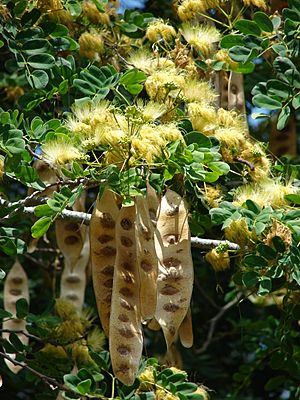Albizia lebbeck facts for kids
Quick facts for kids Albizia lebbeck |
|
|---|---|
 |
|
| Scientific classification | |
| Genus: |
Albizia
|
| Species: |
lebbeck
|
| Synonyms | |
|
Many, see text |
|
The Albizia lebbeck is a type of tree that grows in places like Indomalaya, New Guinea, and Northern Australia. People have also planted it in many other warm, tropical, and subtropical areas around the world.
This tree has many interesting English names, including lebbeck, lebbek tree, flea tree, frywood, koko, and woman's tongue tree. The name "woman's tongue tree" comes from the sound its seeds make when they rattle inside their pods. It's one of the most common Albizia trees, so sometimes people just call it siris.
The Albizia lebbeck is a tall tree, growing about 18 to 30 meters high. Its trunk can be quite wide, from 50 centimeters to 1 meter across. Its leaves are special; they are "bipinnate," meaning they have smaller leaflets arranged on branches. Each leaf is about 7.5 to 15 centimeters long.
The tree's flowers are white and have many long stamens (the parts that hold pollen), about 2.5 to 3.8 centimeters long. They smell very nice! After the flowers, the tree grows long, flat pods, which are a type of fruit called a legume. These pods are 15 to 30 centimeters long and 2.5 to 5 centimeters wide. Inside each pod, you'll find about six to twelve seeds.
In the West Indies and parts of South America, this tree is known as a 'Shak Shak Tree'. This name also comes from the rattling sound the seeds make inside the pods. In Tamil Nadu, India, the tree is called 'vaagai'. Ancient kings used to wear garlands made from its flowers when they won battles. In the Tamil language, 'vaagai' means 'victory'.
What is the Lebbeck Tree Used For?
The Lebbeck tree is useful in many ways. People use it for managing the environment, as food for animals, for traditional medicine, and for its wood.
- Shade: In North and South America, people often plant it as a shade tree because it grows tall and wide.
- Wood: In India and Pakistan, the tree is used to make timber. The wood from Albizia lebbeck is quite strong and dense.
- Animal Food: Even in places where it doesn't naturally grow, some animals, like the greater rhea in Brazil, enjoy eating its leaves and pods.
Traditional Uses
In some cultures, people have used parts of the Lebbeck tree for traditional remedies. For example, some believe it can help with boils, coughs, eye problems, the flu, gum problems (gingivitis), and lung issues. It has also been used as a general tonic and to treat certain growths in the abdomen. The bark is sometimes used to help with inflammation.
It's important to remember that these are traditional uses based on how people have used the plant for a long time. These claims are not always proven by modern science or medical studies.
About its Name
The scientific name of the Albizia lebbeck has a bit of a complicated history. It was first named Mimosa lebbeck by Carl Linnaeus. Later, George Bentham placed it in its current group, or genus, called Albizia.
Sometimes, the name Mimosa speciosa was used for this tree by Nikolaus Joseph von Jacquin. However, another scientist, Carl Peter Thunberg, used Mimosa speciosa to describe a different tree, the Albizia julibrissin. This can make understanding the names a bit tricky! Also, sometimes people misspell the name as lebbek instead of lebbeck.
There is also a group of plants called Lebeckia, which are found only in South Africa. Even though the names sound similar, Lebeckia is not related to Albizia lebbeck. They belong to a different family of plants.
See also
 In Spanish: %C3%89bano de oriente para ni%C3%B1os
In Spanish: %C3%89bano de oriente para ni%C3%B1os


